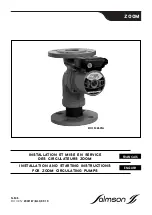
LTC 5136 Series |
Instruction Manual
|
Installation
Bosch Security Systems | 04 September 2003
EN
| 12
4.4
Installation Using an RS-232 Data
Transmission Link to a Biphase
Camera Site
(See Figure 6)
In this application, the RS-232 data that is generated
by the Controller is connected directly to an RS-232
transmission link (fiber optics, microwave, dial-up
phone modems, etc.). The RS-232 transmission link
must be able to support an RS-232 simplex
transmission rate of 9600 baud. At the other end of the
RS-232 transmission link, the RS-232 signal is
converted into Allegiant biphase protocol, using the
supplied interface unit. The biphase data is then
connected to the AutoDome cameras or Allegiant
receiver/driver units.
Install one of the junction boxes supplied in the
LTC 8557 Series Kit (ordered separately) in a location
close enough to the Controller unit so that the supplied
3 m (10 ft) data cable can be used. If desired, four
holes are provided for mounting the LTC 8557 Series
junction box to a flat surface. The power supply (to
power the Controller) should also be located near the
LTC 8557 Series junction box. Connect the bayonet
style connector of the power supply cable into the jack
located on the side of the junction box. If the power
supply cable must be attached to the power supply, the
polarity is not important; the Interface Unit is not
polarity sensitive. Plug the power supply into a suitable
AC power source.
Connect the supplied 3 m (10 ft) data cable with two
RJ-11 connectors, between the Controller unit and the
junction box. The orientation is not important -- either
end may be connected to either device.
Connect an appropriate length of cable (not supplied)
suitable for use with RS-232 signals, between the
LTC 8557 Series junction box and the RS-232
transmission device. If the distance between the box
and device is much over 20-30 m (60-90 ft), the use of
user-supplied short haul modems or other RS-232 line
extender devices may be required. These devices must
be able to support an RS-232 simplex transmission rate
of 9600 baud.
The LTC 8557 Series junction box provides a
removable screw terminal block for the data
connections. The terminal block has four connections
marked 1, 2, 3, & 4. See Figure 2, Junction Box
Supplied with LTC 8557 Series Kit.
Pins 1 and 2 are not used. Pin 3 is the Controller’s
RS-232 TX output, and Pin 4 is the Signal Ground
connection. Be sure to use cable suitable for RS-232
signals. Connect the wire from terminal 3 to the RX
connection of the RS-232 transmission device.
Respectively, connect the wire from terminal 4 to the
data ground connection.
At the camera side of the RS-232 transmission device,
install the interface unit in a convenient location where
it can easily be connected to the transmission device.
NOTE: The interface unit is rated for indoor use only.
If desired, use the four holes provided to mount the
box to a flat surface.
Connect the bayonet style connector of the power
supply cable into the jack located on the side of the
interface unit. If the power supply cable must be
attached to the power supply, the polarity is not
important; the Interface Unit is not polarity sensitive.
Plug the power supply into a suitable AC power
source.
Connect a transmit wire and a signal ground wire from
the RS-232 transmission device to the desired input on
the interface unit. Either the RJ-11 or the 9-pin D type
connector input may be used. Refer to the
Data
Converter Pinouts
section for the appropriate pin
connections.
Next, connect the biphase control code outputs of the
interface unit to the data cable. Typically, a single
camera site receiver/driver is connected to a single
output, but each biphase output of the interface unit is
rated to handle up to eight (8) receiver/drivers when
connected in a
daisy chain
configuration, to a maximum
of 1.5 km (5000 ft). For a
daisy chain
connection, the
cable is looped through each AutoDome camera or
receiver/driver along the way. The last (and
only
the
last) unit in the
daisy chain
connection should be
terminated. All other receiver/drivers should have the
terminating resistor removed when the looping cable is
connected.
Connect shielded twisted pair cable (Belden 8760 or
equivalent) between the camera site receiver/driver
and the biphase output connections located on the
interface unit. The removable terminal blocks have
three connections: (+), (–), and (S [Shield]). See
FIGURE 1, Interface Unit Supplied with LTC 5136.
Select and maintain a wire color convention to avoid
confusion at the camera site(s).
Example: White to (+), Black to (–), and Shield to (S).
NOTE: The shield terminals of the interface unit are
connected to the Shield wire of the cable.






































